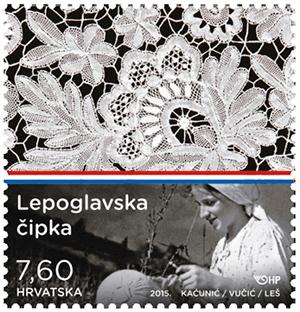
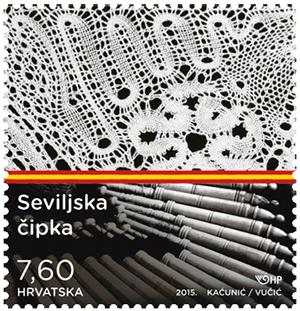
The best known bobbin lace got its name by the municipality of Lepoglava, situated in the Varaždin County, in the north-west Croatia. In Lepoglava in the 19th and 20th century bobbin lace of various techniques and motifs was manufactured. Already at the end of the 19th century the lace craft in Lepoglava became part of the social politics i.e. organised home production, with the aim to ensure an income to village women. A new rise of the lace craft in Lepoglava began in the 1930-ies with Danica Brössler (1912 – 1993), who in a short period of time became an excellent designer and lace craft teacher. Having researched the market and the European lace craft, Danica Brössler changed the by then used technique and motifs and created the recognisable lace which by its technological features can be classified as the Croatian variant of the Duchesse lace. It is a kind of fine lace made of very thin thread and joined floral motifs which were created by various types of interweaving and leaves with low relief ribs. The lace created in this technique was used to make or decorate garments, underwear and home textiles. In Lepoglava, in the period between 1931 and 1942 Danica Brössler organised the work of lace women based on the principles of human work. This period was the „golden period“ of the lace craft in Lepoglava, because its author was awarded a diploma for drafts at the international exhibition in Paris in 1937 and the medal and diploma for the drafts of exhibited lace at the Belin International Crafts Exhibition in 1938. In the last two decades the care for the by then almost dead lace craft in Lepoglava was intensified and encouraged by a number of projects and in 1997 in Lepoglava also the International Lace Festival was founded. The lace craft is of great importance for the local community and thus the bobbin with the wound thread is also represented together with the Pauline Father’s symbol - black raven, in the town's coat of arms. For its importance and role at the local and national level the lace craft of Lepoglava, together with the lace craft of Pag and Hvar was entered in 2009 in the UNESCO's Representative List of the Intangible Cultural Heritage of the mankind.
In recognition of the artistic and cultural values shared by Spain and Croatia, the postal services of both countries will circulate a joint issue dedicated to bobbin lace. The Croatian stamp will show lace from Lepoglava, and the Spanish stamp lace from Seville, both from the early 20th century. One special feature of this issue is that both stamps have perforations in the design, like real lace. Made with silk, linen, cotton, gold or silver thread, lace was created and developed in Europe, spreading throughout the continent. Although its age is impossible to determine, lace became popular in the early 16th century when this delicate fabric became an essential part of European royal court attire. Italy and Flanders specialised in manufacturing, selling and distributing the latest lace fashions that were soon copied by other countries. As one of the decorative arts, lace evolved in line with the artistic styles of each era, and we can identify Venetian, Renaissance, Baroque, Rococo, Art Nouveau, Art Deco or contemporary lace. Bobbin lace requires a pillow to support the pattern, pins to set in the places marked by the patterns, and wooden bobbins, used to wind the threads. Croatia has a rich history of needle lace and bobbin lace making. The tradition is particularly strong in the town of Lepoglava, in the north-west, where an international lace fair is held each year. The piece shown on the stamp was produced by Danica Brösles, who is famous in her country. There is evidence of Spanish lace dating back to the late 15th-early 16th century, when skilled hands created a native style known as "punto español". The lace from Seville depicted on the stamp was made by Cándida García, a teacher who created new models based on those produced in Andalusia since the 17th century, known as twelve-bobbin lace. Patterns were produced for each customer, used only once and signed by the creator.
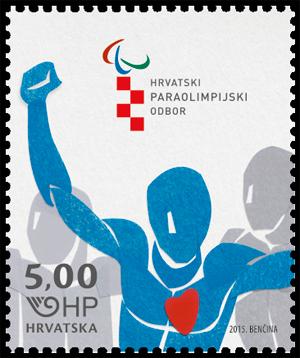 Postage stamp for half a century of Paralympics By issuing this commemorative postage stamp Croatian Post marks the 50 years of Croatian paralympic movement. Half a century of Croatian paralympic sports is at the same time half a century of promoting sports spirit, equal opportunities and possibilities for people with disabilities. Under the moto „Spirit in Motion“, the paralympic sports on global level means the removal of limitations and surpassing of obstacles, even in situations when it appears impossible. This is especially evident in the last twenty years, during which the sports practiced by people with various disabilities has indeed flourished. In Croatia the foundations of paralympic sports and the Croatian Paralympic Committee as the roof organisation, have been set on 8 September 1964 when the Croatian Sport and Recreation League of Disabled was founded. During last fifty years the circumstances have changed, but the goal remained always the same – organisation, promotion and popularisation of sports for persons with disabilities. And, that the persistence pays off, prove best the results. Along with many international rewards and medals, 15 Croatian sportsmen and -women won so far in total 35 paralympic medals. First such medal, already under the flag of the ex-state won Milka Milinković at the Games in Heidelberg, Germany in 1972. Twenty years later at the Games in Barcelona she was again a winner, this time of the first paralympic medal for independent Croatia. With her nine participations and eight medals won, Milinković is today the most successful Croatian sportswoman with disability and next to her is with the same number of medals won in swimming, Roko Mikelin Opara. First paralympic gold for Croatia won Darko Kralj in shot put in Peking in 2008, and with two more gold medals at the same games Antonija Balek joined him. These were the best organised Games in the history at which Croatia was represented by 25 participants in six sports. Besides Darko and Antonija, the 18 years old Branimir Budetić took bronze medal in javelin throw. According to the total number of medals won, Croatian sportsmen and -women were most successful at Paralympic Games in London in 2012. Kralj won silver in shot put in London. Zoran Talić also won silver in long jump and in the same discipline Mikela Ristoski won bronze. Budetić won bronze in javelin throw, as well as Mihovil Španja in 100 m backstroke swimming. In total: five medals. Paralympic Games in London beat the records of total number of participants, number of sold tickets and media covering which meant a turning point in the presentation of attractiveness of sports competition of persons with disabilities. The society is more and more recognising the excellence of paralympic sports and this postage stamp issue is also an important support for the demonstrated courage, determination and equality.
Postage stamp for half a century of Paralympics By issuing this commemorative postage stamp Croatian Post marks the 50 years of Croatian paralympic movement. Half a century of Croatian paralympic sports is at the same time half a century of promoting sports spirit, equal opportunities and possibilities for people with disabilities. Under the moto „Spirit in Motion“, the paralympic sports on global level means the removal of limitations and surpassing of obstacles, even in situations when it appears impossible. This is especially evident in the last twenty years, during which the sports practiced by people with various disabilities has indeed flourished. In Croatia the foundations of paralympic sports and the Croatian Paralympic Committee as the roof organisation, have been set on 8 September 1964 when the Croatian Sport and Recreation League of Disabled was founded. During last fifty years the circumstances have changed, but the goal remained always the same – organisation, promotion and popularisation of sports for persons with disabilities. And, that the persistence pays off, prove best the results. Along with many international rewards and medals, 15 Croatian sportsmen and -women won so far in total 35 paralympic medals. First such medal, already under the flag of the ex-state won Milka Milinković at the Games in Heidelberg, Germany in 1972. Twenty years later at the Games in Barcelona she was again a winner, this time of the first paralympic medal for independent Croatia. With her nine participations and eight medals won, Milinković is today the most successful Croatian sportswoman with disability and next to her is with the same number of medals won in swimming, Roko Mikelin Opara. First paralympic gold for Croatia won Darko Kralj in shot put in Peking in 2008, and with two more gold medals at the same games Antonija Balek joined him. These were the best organised Games in the history at which Croatia was represented by 25 participants in six sports. Besides Darko and Antonija, the 18 years old Branimir Budetić took bronze medal in javelin throw. According to the total number of medals won, Croatian sportsmen and -women were most successful at Paralympic Games in London in 2012. Kralj won silver in shot put in London. Zoran Talić also won silver in long jump and in the same discipline Mikela Ristoski won bronze. Budetić won bronze in javelin throw, as well as Mihovil Španja in 100 m backstroke swimming. In total: five medals. Paralympic Games in London beat the records of total number of participants, number of sold tickets and media covering which meant a turning point in the presentation of attractiveness of sports competition of persons with disabilities. The society is more and more recognising the excellence of paralympic sports and this postage stamp issue is also an important support for the demonstrated courage, determination and equality.
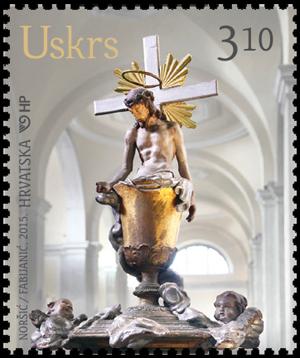 On the acropolis of Rovinj there stands a wonderful and ancient Church of St. Euphemia. On the place of a pristine small house of worship, with sarcophagus and earthy remains of the old Christian woman martyr, overlooking the sun-bathed sea, the church developed in the period of Baroque to its today's impressive size and gorgeous outfit. Although in the period of Napoleon's conquest it remained without an important part of its treasury, it is still full of precious works of art, some of which were made by famous artists, while the others speak from their anonymity, using clear stylistic language of the period. Among these last, worth mentioning is a very interesting procession inventory, several baroque wooden sculptures or groups of sculptures on long rods. These sculptures stand in lateral chapels and interconnected by a walk through the church, create an entire small theatre. That impression is even more powerful if you imagine them in movement, lifted high above a mass of people, moving like saint dolls in ceremonies, communicating in their gold and silver with light and enlightening the semi-darkness. The most unusual among these figures can be associated with Easter. Actually, its rare and direct metaphoric suggests it. From the golden chalice, like live Host, there rises - it could also be said there emerges - from the waist upwards, Christ’s body. Christ is leaning on the cross with golden rays, holding in hands his loincloth which, turning into a baroque ornament, overflows to reach the small angel at the bottom of the chalice. The artist restored the “Take, eat; this is my body” from the transformation in bread and stylisation in Host to a realistic starting point. By double inversion the Host is not understood as the body, but the body is understood as the Host. Equally, read in the same key, the substance in chalice out of which the Christ's body emerges, is not wine, but blood. The chalice is, of course, a sacrificial dish, a dish of transubstantiation, and the substance which is generated in it rises into the heights, showing the way. In that height, the height of liberation, also the idea of sacrifice is expressed. That idea and that promise is Easter.
On the acropolis of Rovinj there stands a wonderful and ancient Church of St. Euphemia. On the place of a pristine small house of worship, with sarcophagus and earthy remains of the old Christian woman martyr, overlooking the sun-bathed sea, the church developed in the period of Baroque to its today's impressive size and gorgeous outfit. Although in the period of Napoleon's conquest it remained without an important part of its treasury, it is still full of precious works of art, some of which were made by famous artists, while the others speak from their anonymity, using clear stylistic language of the period. Among these last, worth mentioning is a very interesting procession inventory, several baroque wooden sculptures or groups of sculptures on long rods. These sculptures stand in lateral chapels and interconnected by a walk through the church, create an entire small theatre. That impression is even more powerful if you imagine them in movement, lifted high above a mass of people, moving like saint dolls in ceremonies, communicating in their gold and silver with light and enlightening the semi-darkness. The most unusual among these figures can be associated with Easter. Actually, its rare and direct metaphoric suggests it. From the golden chalice, like live Host, there rises - it could also be said there emerges - from the waist upwards, Christ’s body. Christ is leaning on the cross with golden rays, holding in hands his loincloth which, turning into a baroque ornament, overflows to reach the small angel at the bottom of the chalice. The artist restored the “Take, eat; this is my body” from the transformation in bread and stylisation in Host to a realistic starting point. By double inversion the Host is not understood as the body, but the body is understood as the Host. Equally, read in the same key, the substance in chalice out of which the Christ's body emerges, is not wine, but blood. The chalice is, of course, a sacrificial dish, a dish of transubstantiation, and the substance which is generated in it rises into the heights, showing the way. In that height, the height of liberation, also the idea of sacrifice is expressed. That idea and that promise is Easter.
 Rotarians promote tolerance, friendship and peace Rotarian movement, founded in 1905, represents a mini model of a peaceful world which could serve as an example to all nations. "Rotarians believe that it is possible to achieve what each person yearns for, like tolerance, friendship and world peace.” With these words Paul P. Harris, the Rotary’s founder described the purpose and actions of the huge Rotarian family. The Statute of the Rotary Club Zagreb, first Croatian Rotary Club in the Republic of Croatia and a member of Rotary International defines that “the purpose of all Rotarians is readiness to help other people in everyday life”, which is achieved by: 1.) cherishing friendship; 2.) following high ethical principles in private and professional life and taking actions of importance for the entire community; 3.) developing responsibility in private, professional and public life of all Rotarians; 4.) cherishing mutual understanding and promoting peace among all nations in the world, united in the world community of specialists guided by the idea of serving” (Statute, cl. III, 1- 4).
Rotarians promote tolerance, friendship and peace Rotarian movement, founded in 1905, represents a mini model of a peaceful world which could serve as an example to all nations. "Rotarians believe that it is possible to achieve what each person yearns for, like tolerance, friendship and world peace.” With these words Paul P. Harris, the Rotary’s founder described the purpose and actions of the huge Rotarian family. The Statute of the Rotary Club Zagreb, first Croatian Rotary Club in the Republic of Croatia and a member of Rotary International defines that “the purpose of all Rotarians is readiness to help other people in everyday life”, which is achieved by: 1.) cherishing friendship; 2.) following high ethical principles in private and professional life and taking actions of importance for the entire community; 3.) developing responsibility in private, professional and public life of all Rotarians; 4.) cherishing mutual understanding and promoting peace among all nations in the world, united in the world community of specialists guided by the idea of serving” (Statute, cl. III, 1- 4).
Serve others without personal gain is not just a Rotarian motto but also the characteristic of the ring connecting today more than a million of Rotarians in 25,000 clubs in 160 countries of the world. To this great family belongs from 1990 also Croatia with its first Rotary Club Zagreb, founded after Croatian people had voted in democratic elections its freedom and independent Republic of Croatia. Today, Croatian Rotarian family is active in almost all major towns of the Republic of Croatia. During aggression on the Republic of Croatia Rotarians organised a series of humanitarian and charity activities for the benefit of refugees and children who in the Homeland War lost both parents. Although each Rotarian has private reasons for his/her religious and political view of life, it is still expected from Rotarians to be faithful patriots and openly uphold their religious belief.
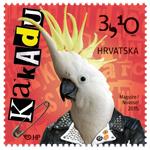
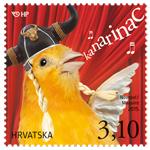
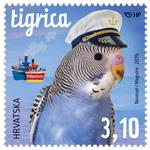
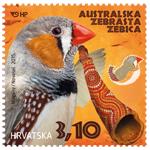
Sulphur-crested cockatoo
(Cacatua Galerita)
The native country of this beautiful bird is Australia, where it lives in flocks of about hundred birds. It is characterised by a splendid yellow crest. Its basic colour is white, only below wings and on the back the feather is of intensive yellow colour. It feeds on seeds, fruit, and vegetables and as a titbit an insect or its larva will do. A pair which mates remains together for the whole life and the life span of the bird is about seventy years. In its country of origin it is considered vermin. Australia forbid the export of autochthonous kinds of animals, and thus also of cockatoo. The species bred throughout the world are greatly legally exported birds or their offspring. From all kinds of cockatoo, and there are about twenty kinds, the sulphur-crested cockatoo is the most widespread pet.
Canary
(Serinus Canaria)
The canary's homeland is Canary Islands, which did not get their name by the bird but by dog, canus in Latin language. In nature it is a small bird about 10-15 cm long, weighting 10-20 grams. Its colour is yellow-greenish and it sings beautifully. It feeds on ripe and half-ripe seeds of various grass, fruit and buds and small worms and plant louses. During mating season the mates separate from the flock, looking for food.
Budgerigar
(Melopsittacus Undulatus)
Budgerigar is the best known representative of the parrot family and the most common pet in the world. Its country of origin is Australia, where it lives in large flocks. It feeds on different seeds and fruit. During 19th century the seafarers brought it to Europe and their breeding and cross-breeding began resulting in great number of mutations in colour and size. In nature their basic colour is green with tiger design on feathers. A vast palette of colours ranges from entirely white to indigo blue and also in many combinations of blue, yellow and green. Their size is from 15 to 22 cm.
Zebra finch
(Poephila Guttata)
The country of origin of zebra finch is Australia, where it lives in great flocks, which - with reference to the bird’s size of about ten centimetres, weight of about ten grams and a relatively slow flight - ensures its survival. The males - as is the case with many birds - have nicer colours than females which partly serve them for easier attraction of females and partly for being more easily noticeable to potential enemies and thus able to draw enemy’s attention away from their partners and the nest with offspring. They feed mainly on seeds of various sorts of grass, but enjoy also eating different green plants and fruit.
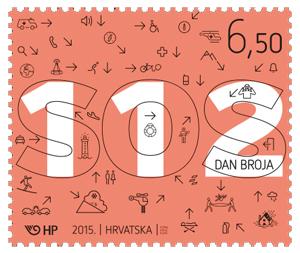 On 29 July 1991 the Council of European Communities brought the Decision on introducing a unique European urgency services number 112 (Council Decision 91/396/EEC) which integrates all urgency services into a unique service of providing help, the System 112 with the main purpose to provide overall help in cases of threatened health and lives of people as well as material goods and environment. The 112 System was operationally introduced in the Republic of Croatia on 11 February 2005 and has following features and advantages for both - the callers as well as the urgency services: The number 112 is available daily round the clock in all states members of the European Union and the calls are free of charge from all public phone boxes, mobile or fixed telephones. The caller does not need to know particular telephone numbers and authorised territorial and specialised urgency services, which is a special advantage for tourists or callers in stressful situations.
On 29 July 1991 the Council of European Communities brought the Decision on introducing a unique European urgency services number 112 (Council Decision 91/396/EEC) which integrates all urgency services into a unique service of providing help, the System 112 with the main purpose to provide overall help in cases of threatened health and lives of people as well as material goods and environment. The 112 System was operationally introduced in the Republic of Croatia on 11 February 2005 and has following features and advantages for both - the callers as well as the urgency services: The number 112 is available daily round the clock in all states members of the European Union and the calls are free of charge from all public phone boxes, mobile or fixed telephones. The caller does not need to know particular telephone numbers and authorised territorial and specialised urgency services, which is a special advantage for tourists or callers in stressful situations.
By calling 112 one can get help from any urgent service (police, firefighters, urgent medical help, mountain rescue service, inspectional, communal or other service interconnected in the protection and rescuing system). System 112 enables locating the caller of 112, receiving urgent call in foreign languages, initiating search and rescue actions at sea or mainland, urgent air transport of transplantation organs, of injured persons, search and rescue teams, firemen and the engagement of citizens’ associations which with their competences contribute to the protection and rescue system (hunters, divers etc.) Time is saved, since one call activates at the same time several services, i.e. the operator after receiving a call at 112 alarms and coordinates all urgent services needed in a particular case.
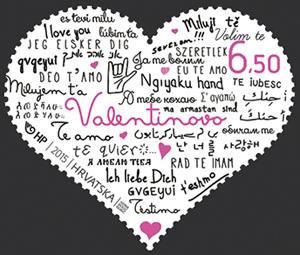 There is no more sublime feeling than the feeling of sincere, devoted and eternal love. Every year, on 14 February , this love is celebrated by millions of those in love throughout the world and according to number of Valentine's cards and messages sent, this day stands shoulder to shoulder with other great world's holidays. The privilege to celebrate the day dedicated to love is owed to the bishop Valen-tine, who lived in 3rd century in Rome. At that time Christianity was young and new reli-gion and the Christians were pursued and prosecuted. Valentin tried to help them in all possible ways, he performed and supported Christian marriages and gave roses from his garden to all those who married. He offered help to all who asked his advice opposing himself to the order by the Emperor Claudius II Gothicus, who at that time forbid engagements and marriages to soldiers believing that they won’t be willing to take part in wars if they have a wife and children waiting for them at home. Because of his devotedness to Christianity and to wedding ceremony the Bishop Valentine was imprisoned and on 14 February (on the eve of the Roman spring holiday Lupercalia) decapitated. The folks, who were especially fond of Valentine, soon proclaimed him a saint and the patron of young and those in love. When, after some time, Christianity consolidated in Rome the priests also proclaimed 14 February as the St. Valentine's Day. The first to do so was the Pope Gelasius I in 496 and in 1969 the Pope Paul VI erased the day from the main catholic calendar of saints, so that the day became an optional remembrance day.
There is no more sublime feeling than the feeling of sincere, devoted and eternal love. Every year, on 14 February , this love is celebrated by millions of those in love throughout the world and according to number of Valentine's cards and messages sent, this day stands shoulder to shoulder with other great world's holidays. The privilege to celebrate the day dedicated to love is owed to the bishop Valen-tine, who lived in 3rd century in Rome. At that time Christianity was young and new reli-gion and the Christians were pursued and prosecuted. Valentin tried to help them in all possible ways, he performed and supported Christian marriages and gave roses from his garden to all those who married. He offered help to all who asked his advice opposing himself to the order by the Emperor Claudius II Gothicus, who at that time forbid engagements and marriages to soldiers believing that they won’t be willing to take part in wars if they have a wife and children waiting for them at home. Because of his devotedness to Christianity and to wedding ceremony the Bishop Valentine was imprisoned and on 14 February (on the eve of the Roman spring holiday Lupercalia) decapitated. The folks, who were especially fond of Valentine, soon proclaimed him a saint and the patron of young and those in love. When, after some time, Christianity consolidated in Rome the priests also proclaimed 14 February as the St. Valentine's Day. The first to do so was the Pope Gelasius I in 496 and in 1969 the Pope Paul VI erased the day from the main catholic calendar of saints, so that the day became an optional remembrance day.
For billions of those in love throughout the world this saint, who in a sense died for love, is the veritable patron of all who are in love. Although many people today will criticize the celebration of Valentine’s Day because of its commercialisation, the fact is that it is celebrated in the whole world. On that day women and girls in the whole world receive about 50 tons of roses, many pairs want to legalise their relationship just on St. Valentin's Day, and even those who during year forget to give presents and show their beloved persons that they care about them stop for a moment and apprehend the deepest meaning of love – it is at its best when generously shared!